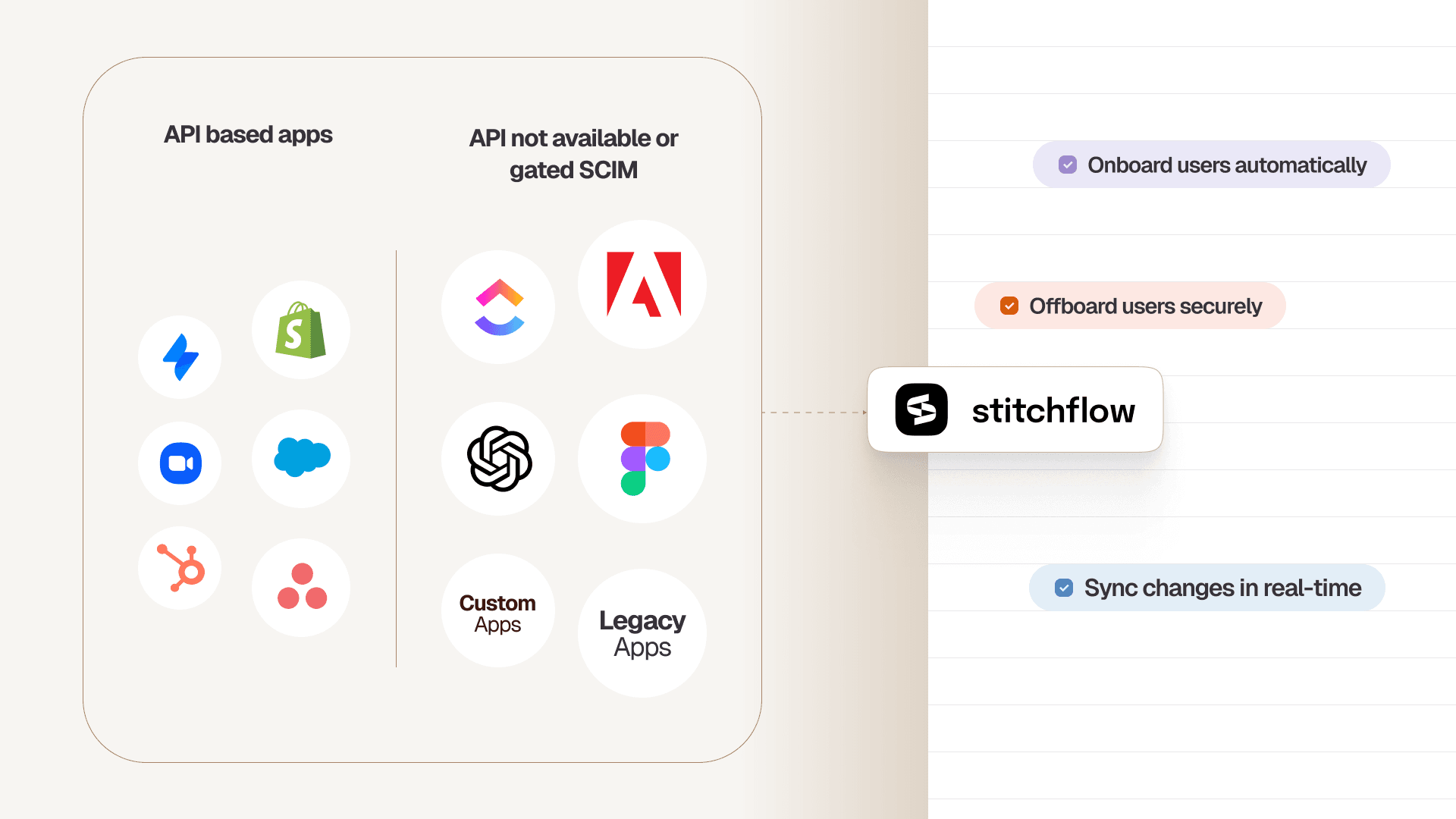There’s a quiet problem lurking inside every fast-moving IT environment, and it’s not phishing, ransomware, or patching delays.
It’s disconnected apps.
These are the tools that don’t integrate with your identity provider (IdP). They don’t support SCIM. Workflows do not automate them. They often live in spreadsheets or CSVs. And yet, they’re used by your employees, contractors, and sometimes even by former employees. They store sensitive data and quietly drain your IT budget.
This blog will break down more about disconnected apps and why they are a significant blind spot for IT, Security, and Compliance teams, and why traditional SaaS management platforms and identity tools are not enough.
What exactly are disconnected apps?
Disconnected apps are tools that don’t integrate with your identity provider (IdP), meaning they aren't automated or governed by SSO or SCIM. And yet they’re being used across your company every day, by employees, contractors, and sometimes former team members.
Common examples:
- Apps on lower-tier SaaS plans without SSO/SCIM
- Legacy platforms like NetSuite, ADP, or homegrown systems
- AI tools and browser-based apps with no access controls
- CSV-based systems used by Finance or Ops
- Vendor accounts or tools spun up by Marketing, HR, or Product without IT involvement
If you can’t automatically see who has access or shut it down through your IdP, it’s a disconnected app.
Why disconnected apps are more than an inconvenience
In fast-scaling orgs, disconnected apps create four major problems:
1. Orphaned accounts pose a real security risk
When users leave and their access isn’t revoked, those accounts become prime targets for insider threats or external exploitation. Disconnected apps are where these accounts hide.
2. License waste adds up quickly
Without visibility, licenses remain assigned to inactive users or go unused entirely. Multiply that by 50+ tools across departments, and the spend adds up fast.
3. Compliance reviews break down
Disconnected apps are often where audits fail. Access logs are missing. Evidence is stale.
Compliance teams end up chasing down screenshots, spreadsheets, and CSVs just to prove someone no longer has access.
4. IT loses valuable time
Every manually deprovisioned app requires upkeep, custom logic, and human follow-through. It’s not sustainable at scale.
The Real Problem: "SCIM Tax" and Ransom Economics
Most organizations assume their IdP handles everything. The truth is, IDPs only handle the 60-70% of apps that are integrated.
The remaining 30-40% of apps are disconnected for one simple reason: it's a business model.
SaaS vendors know that as you scale, you need automated (de)provisioning (SCIM) for security and compliance. They also know that enterprises will pay anything for it.
So, they practice "ransom economics":
- They take a basic, necessary feature like SCIM.
- They bundle it only with their most expensive "Enterprise" plan.
- They charge you a "SCIM tax" of $10+ per user, per month, for your entire user base, even if you just need the one feature.
For mid-market companies on a budget, this leaves two bad choices: pay the ransom or manage a growing list of apps with manual clicks and spreadsheets. Disconnected apps are no longer an edge case; they are a direct consequence of this vendor strategy.
What leading IT teams are doing about it
Manually (de)provisioning users is more than an inconvenience; it’s a significant time drain and a major security risk.
For every app that lacks SCIM, IT teams are forced to log into its admin console for every new hire, role change, and departing employee. This repetitive, manual process is not scalable and inevitably leads to orphaned accounts, wasted licenses, and compliance headaches.
Instead of being stuck with these bad choices, Stitchflow’s managed IT automation bridges the gap.
This provides reliable, API-like control by securely automating the exact admin actions you'd perform in the browser, even for apps without SCIM or APIs.
Here’s how it works:
- Automate Deprovisioning for Any App: Stitchflow builds and maintains a resilient browser automation that mimics the exact admin actions you perform manually. This allows your existing IdP (like Okta or Entra) to automatically handle (de)provisioning for any app, just as if it had a native SCIM connection.
- Guaranteed Reliability (HITL): Unlike brittle RPA scripts that you have to build and maintain, Stitchflow guarantees reliability. When a UI change, CAPTCHA, or MFA challenge breaks the automation, our 24/7 human-in-the-loop (HITL) on-call engineers are immediately alerted, fix the issue, and ensure the workflow completes.
Real Impact We’ve Seen in the Field
This approach delivers immediate, quantifiable results. Our latest business value report from SpotOn highlights the direct impact:
- Found and fixed over 550 offboarding and compliance gaps
- Realized over $90,000 in annual license savings and reclaimed 250 unused Salesforce user licenses
- Found and cleaned up over 1,000 SaaS accounts
- Freed up over 400 hours of IT time (the equivalent of 75% of one full-time employee)
None of this required custom setup, workflow scripting, or upgrading every app to the SCIM-enabled enterprise plan.
“We eliminated two hours of spreadsheet work per offboarding by automating access reviews across disconnected apps, and closed the gap that worried our auditors.”
— Amit Sharma, IT Administrator, Turing
Unlock SCIM for any app without the enterprise upgrade
Trigger automated provisioning in your IdP just like native SCIM. Enabled by resilient browser automation, backed by 24/7 human monitoring, at a fraction of the enterprise plan cost.

The takeaway: You don't have to live with manual work
Disconnected apps aren't just an inconvenience; they are a direct drain on your time and budget. Every new app your team adopts—whether it's an AI tool for engineering or a new app for marketing—adds to your list of manual (de)provisioning tasks.
This is the "automation gap" that leads directly to orphaned accounts when people leave, license waste on inactive users , and weeks spent chasing spreadsheets for compliance audits.
For years, the only "solutions" were to either:
- Pay the "SCIM Tax"—an expensive, per-user upgrade for a single feature.
- Accept the Manual Work—and the 2+ days per week of IT time it costs.
Managed browser automation provides a practical third option.
It gives you the full power of SCIM for any app with a web admin console. Because it's a fully managed service guaranteed by a 24/7 human-in-the-loop team, you get reliable, automated (de)provisioning without the brittleness of RPA or the high cost of enterprise plans.
As the SpotOn data shows, the impact is immediate: over 400 hours of IT time reclaimed, $90,000+ in license savings, and 550+ security gaps closed.
You can finally automate 100% of your apps.
Want to see how this works for your most problematic apps?
Frequently asked questions
A disconnected app is any SaaS tool not integrated with your identity provider (IdP) or automated provisioning system. These apps typically lack SCIM or SSO support, rely on manual access management, or fall outside IT visibility, making them harder to audit and govern.
Jay has been serving modern IT teams for more than a decade. Prior to Stitchflow, he was the product lead for Okta IGA after Okta acquired his previous ITSM company, atSpoke.



